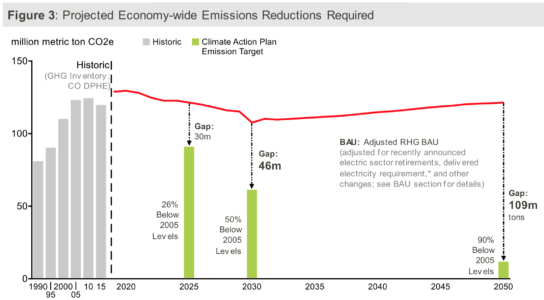Adapted from EDF materials by Martin Voelker.
A new analysis commissioned by the Environmental Defense Fund and Western Resource Advocates brings sobering news: Using only currently planned policies Colorado’s emissions will massively fail to meet its mandatory emissions goals.
“Colorado set nation-leading, science-based goals to cut greenhouse gas pollution across our economy by mid-century, in order to do Colorado’s part to limit global warming to 1.5 degrees Celsius and ensure we maintain a healthy, livable climate,” said Stacy Tellinghuisen, senior climate policy analyst at Western Resource Advocates. “But this analysis shows we can’t succeed if we just continue business as usual. We need – and Coloradans want – ambitious action that meets the urgency of the climate crisis we face. It’s going to take hard work, but Colorado has an opportunity to lead on climate, while growing our economy and preserving our way of life.”
This also represents a legal issue because meeting the goal is required by law, as signed by Governor Jared Polis in May 2019.
While Governor Polis is generally known for his emphasis on climate it’s noteworthy that at this point only two strategies for emission reductions have his full support, namely the electrification of light-duty vehicles and methane regulations in the oil and gas sector. But frankly, that isn’t good enough because these two elements have a comparatively small reduction impact. A massive political push is also needed for the electrification and alternate fuel use in homes and businesses, aggressive building codes, regulations on hydrofluorocarbons and further action in the power sector.
The analysis performed by M.J. Bradley & Associates specifically looked at potential emissions reductions by sector. The full report is available here.
Key findings from the analysis include:
•Under current policies, Colorado will exceed its 2025 economy-wide emission goal by 30 million metric tons. While state law requires the state’s climate pollution to decline to an estimated 92 million metric tons by 2025, Colorado is projected to emit 121.3 million metric tons of greenhouse gas pollution.
•This reflects a modest decline from 2005 levels; however, it masks important sector-specific changes in emissions. Greenhouse gas pollution from the electricity sector is projected to decline significantly, while pollution in other sectors, such as oil and gas, increased from 2005 to 2015.
•Under current policies, Colorado will exceed its 2030 economy-wide emission goal by 46 million metric tons. The state’s emissions are projected to decline to 108 million metric tons in 2030; however, Colorado law to protect public health, the environment, and the economy from climate pollution requires emissions not exceed an estimated 62 million metric tons.
•If the state adopted several important policies currently under discussion with certain assumptions, it could further reduce emissions by an estimated 21 million metric tons in 2030. That would leave a gap of 25 million metric tons in 2030.
•Of the abatement measures under the scopes considered in the analysis, the sectors with the greatest emission reduction potential are the power sector and the oil and gas sector. In the power sector, if the state retired additional coal plants in 2030 and replaced them with zero-carbon sources of energy, the report estimates that greenhouse gas emissions could be reduced by approximately 7 million metric tons. Protective regulations on methane pollution from oil and gas facilities, building on the regulations enacted under SB 19-181 in December 2019, could reduce emissions from that sector by 4 million to 5 million metric tons.
Last week, representatives of dozens of organizations and impacted community members wearing clock costumes, holding “Out Of Time” clock signs and a “Mind the Emissions Gap” banner, spoke at the AQCC Hearing and held a press conference calling out Gov. Polis for his inaction on this issue. They then delivered the joint group letter and gave passionate testimony to the Commission. The Colorado Coalition for a Livable Climate, comprised of 33 organizations, also submitted a group letter and testimony. Read the press release here.
Did you enjoy this blog post? If so, please consider donating to 350 Colorado to help fund our work reduce emissions in Colorado. Click here to make a donation!

